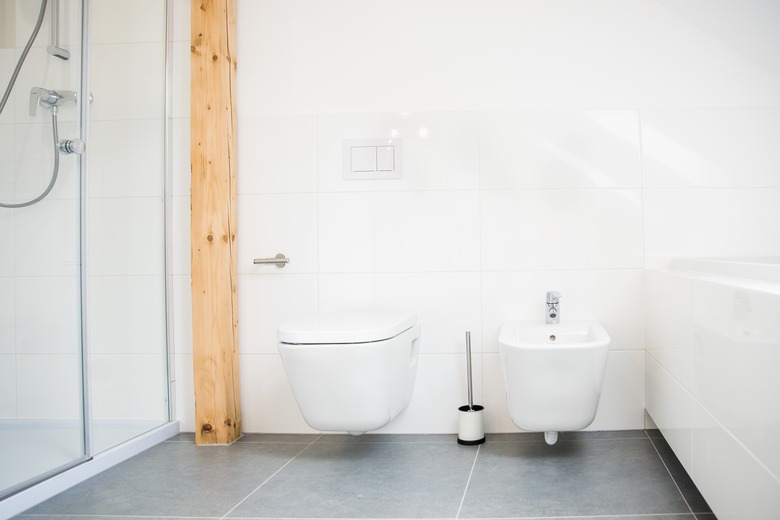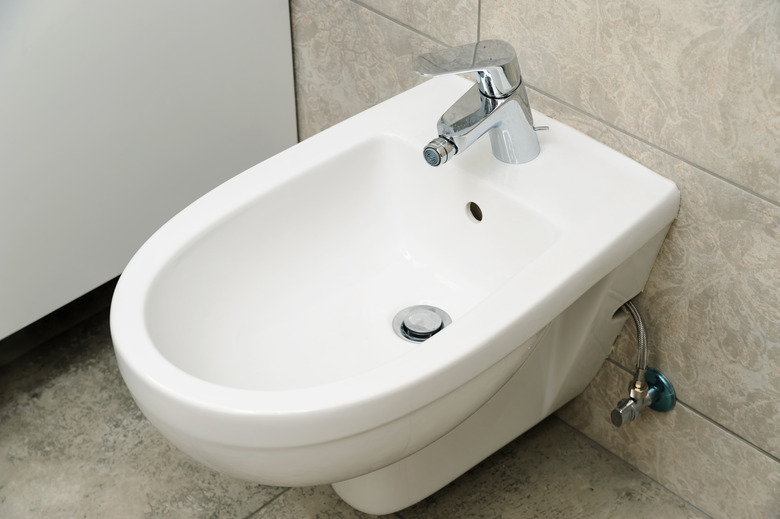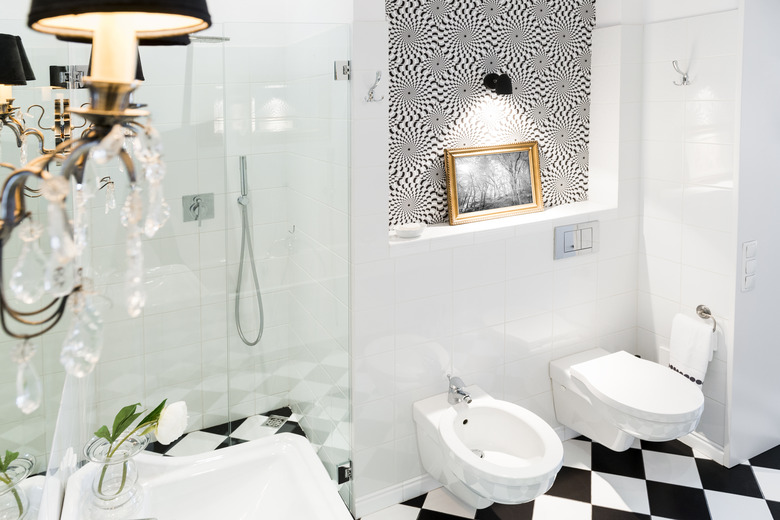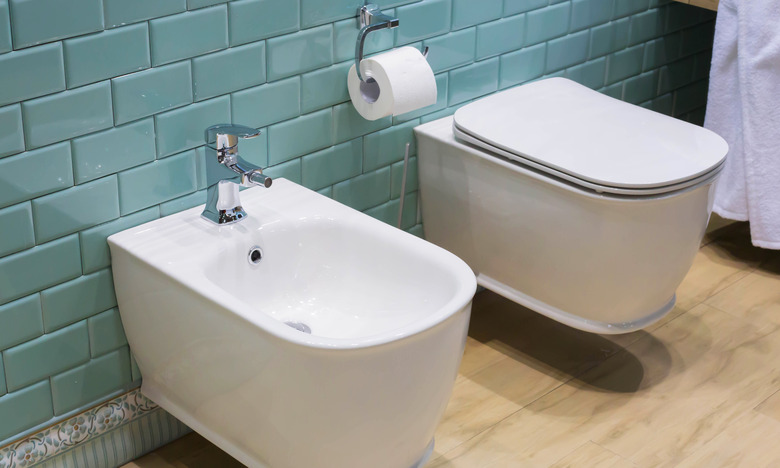A Homeowner's Guide To Bidets And Bidet Seats
We may receive a commission on purchases made from links.
While many Americans swear that the only way to clean yourself after using the restroom is with good old-fashioned toilet paper or maybe flushable wipes, other cultures have long celebrated the unrivaled cleanliness of the bidet. In recent years, bidets have also been gaining popularity in the United States, especially with the introduction of the bidet toilet seat, which doesn't require extra space and a major installation process like a traditional stand-alone bidet.
In fact, Good Housekeeping says that over 54 percent of Americans think that adding a bidet of some kind to their bathroom would make it feel more luxurious. If you're considering adding a bidet to your home, there are several key considerations to keep in mind.
How to Use a Bidet
How to Use a Bidet
The specifics of how to use any bidet will vary based on the actual model and type, but whether you're using a stand-alone bidet or an integrated toilet seat design, the basics are the same.
- Figure out the controls. Before trying to use a specific bidet,
you'll want to familiarize yourself with how it works, especially since it may
be hard to read the controls while trying to use it. Find out if that
specific model offers the ability to control the water pressure, temperature
and location of the spray and then find out how to turn the settings on and
off so you can feel comfortable and properly position yourself. Because some
bidets have a powerful spray when the water pressure is turned all the way up, you may
want to place your hand over the nozzle while exploring the functions to
prevent it from spraying where it's not wanted. - Always use the toilet first. Remove your pants before using the
toilet to make the bidet experience easier while you're still learning how to
use it. Be aware that because they don't actually flush and they drain very slowly,
stand-alone bidets cannot be used as a toilet or urinal and can only be used for
cleanup after using the toilet. When using a stand-alone bidet, use toilet
paper once to remove any solid waste from the anal area before using the bidet,
but you can bypass this step if you are using any form of bidet/toilet combination. - Position yourself. Whether you are using a standard bidet, an integrated
bidet/toilet or a bidet toilet seat, you need to get in the right position so
the bidet's stream of water will clean you properly. Some people like to sit on
the bidet seat, but many users prefer to
straddle it. Some bidets with both a front and rear spray nozzle allow users
the option of sitting away from the controls or toward them, which makes it
easier to use when you're still getting the hang of the bidet operations. When using a
handheld bidet sprayer, this isn't as much of an issue because you control
where the spray goes. - Clean yourself. Clean yourself like you would in a bath or
shower. While some people use soap, hygiene experts say that water alone is enough and
warn that soap can dry out and irritate your delicate membranes. If a
stand-alone bidet has a faucet and taps rather than a spray nozzle, you may need
to fill it up with water and use your hands to lift and splash yourself with water
as though you were using a sink to wash your face. - Dry yourself. Some modern bidets have an air dryer, but in most
cases, you'll need to pat yourself dry with toilet paper or a paper towel. Do
not skip this step, as a wet derriere can moisten your pants, potentially
causing embarrassing social situations, and it can lead to fungal and bacterial
growth that can result in odor and infections. If you are using a stand-alone bidet, throw
paper waste in the toilet or trash can, as they cannot dispose of solid waste of
any kind. If you are using a towel, put it in a hamper. - Rinse the bidet. It's considered good etiquette to rinse a
stand-alone bidet before the next person uses it. If you are using a bidet that works on
the toilet, flush as usual. - Wash your hands. As always, wash your hands with soap and water
before leaving the restroom.
Common Misconceptions
About the Bidet
While bidets are well-loved in countries across the world, including France, Japan, Singapore, Italy, Argentina, Portugal, Venezuela and large portions of the Middle East, there remain a lot of misconceptions about them in areas where people still prefer using toilet paper alone. Some of the most common myths you've likely already heard about bidets include:
- Bidets are unhygienic. In fact, the opposite is true, and bidets are
far more hygienic than toilet paper. It makes sense — if you get raw meat on
your hands while cooking, do you just rub them on a dry towel, or do you clean
up with soap and water? Why would using only dry paper be an advantage when it
comes to the bacteria from fecal matter? - Bidets spray everywhere. While you could potentially make a mess if
you chose to turn the spray all the way up and position the sprayer to shoot as
far as possible and then run the bidet without sitting above it, the same could
be said about an adjustable shower sprayer. As long as you aren't actively trying to make a mess, chances are that you won't. - Bidets are uncomfortable. While some people who are new to bidets find the idea of
spraying cold water on their rear ends to be discomforting, the fact
is that some people find it refreshing, and many bidets offer the ability to
control the water temperature, so you can usually choose to clean with warm water
the same way you do in the shower. If you have a medical condition like
hemorrhoids, bidets are substantially more comfortable, as toilet paper can easily irritate an already-sensitive area. - Bidets take up too much space. While needing the space for a
separate bidet fixture was once a common setback for those interested in them,
that's not a problem now thanks to integrated bidet/toilet fixtures, bidet
sprayers and toilet seat bidets, none of which take up any more space than your
existing toilet. - Bidets are expensive. Bidet toilet seats and sprayers can be found
for less than $50. Considering that they can cut your toilet paper use by 75
percent, having a bidet can actually save you money in the long run. - Bidets are hard to use. While they can seem intimidating the first
one or two times you try them, bidets are actually fairly simple, especially
those that are incorporated into the toilet. They are also easier for people with disabilities to use, as those who cannot easily reach down and clean themselves
with toilet paper tend to find bidets more comfortable and simpler to use, especially models with handheld remote controls. - Bidets are bad for the environment. Yes, they can use a little more
water, but toilet paper production also uses a lot of water. Plus, toilet paper is made from
virgin forest wood, and a lot of carbon dioxide is expelled during the
manufacturing and transportation of the rolls. Bidets can reduce the environmental impacts of toilet paper by 75 percent or more; however, many bidets use electricity. - Bidets require special plumbing. Again, this is true for all stand-alone
bidets, and a manual model that uses hot water might need to be connected to the
hot water line under your sink, but most modern bidet solutions can use your
existing toilet's plumbing. Better still, while toilet paper can plug up your
plumbing, bidets reduce this risk, particularly for those who enjoy the clean
feeling of flushable wipes (which are notoriously bad for plumbing). - Bidets aren't good for your health. While it's true that it can be
unhealthy to use a bidet and fail to dry your bottom since wetness can cause an
increase of bacterial and fungal growth, overall, bidets are actually healthier
than toilet paper. In fact, just about everyone has felt the painful
consequence of wiping a bit too hard to get clean with toilet paper, and while you
might be inclined to use wipes instead, Consumer Reports notes that colon and rectal surgeons recommend avoiding wipes
because they often contain drying agents that can result in irritation and
other issues.
Different Types of Bidets
Different Types of Bidets
There are four main types of bidets, each with their own benefits: stand-alone bidets, bidet sprayers, bidet toilet seats and integrated bidet/toilet combinations. It's important to familiarize yourself with the different styles when considering the right option for your home.
- Stand-alone bidet. Sometimes called
a bidet toilet, these are the original bidet style — separate fixtures that are
generally installed next to the toilet. This means they take up the most space
and cost the most to install since you need to hire a plumber to add new
plumbing connections. Most modern designs have hot and cold knobs that also
allow you to determine the water pressure coming from the sprayer, which can be
adjusted for height. Older designs are those that work more like sinks that
must be filled up before you manually splash the water up on your body with
your hands. It's worth mentioning that these may be difficult for both children
and the elderly to use because they often require straddling the bowl. - Bidet sprayer. The least expensive
option, these are connected to the toilet tank and consist of nothing more than
a handheld sprayer that is usually attached to the toilet tank or wall. While most designs
only use cold water, some models can be hooked into a hot water supply and have
temperature controls. One benefit of a sprayer bidet attachment is that it is
easy to use since it can be aimed and sprayed, similar to a kitchen faucet
sprayer. Also, they don't take up much space and can be easily installed and removed
without professional help, which makes them a good option for renters. - Bidet toilet seat. These are seats that
you can install on your existing toilet that are outfitted with bidet nozzles and
controls. These can save you money over a full integrated bidet/toilet combination
or a stand-alone bidet. The
controls may be attached to the side of the seat or built into a handheld remote.
When buying a bidet toilet seat, make sure you buy one that is the right size
for your toilet, especially if you have an elongated bowl. - Integrated bidet/toilet. The most
expensive and luxurious of all options, an integrated bidet toilet is a toilet
that comes with a built-in bidet, offering you the best of both worlds. They
are usually the most expensive of all bidet options because they tend to come
loaded with high-tech features.
Electric Versus Manual Bidets
Electric Versus Manual Bidets
Bidets are either manual or electric, and it's important to know which one you are looking for before shopping, or you may be disappointed by what you bring home. Almost all stand-alone and sprayer bidets are manual, integrated bidets are usually electric and bidet toilet seats can be manual or electric depending on their features.
A manual bidet is any design that does not require batteries or an outlet. Generally, this means they do not offer heated water, although a few have designs that can be hooked up to a hot water connection in your bathroom. Manual models tend to have relatively few features, frequently only allowing you to control little more than the pressure and angle of the spray.
Electric models, as the name implies, use electricity. The most famous electric bidet is the well-known Toto Washlet. The most basic electric models simply use the power to heat up the water, but more advanced models often feature all kinds of bells and whistles not just limited to hot and cold water but also heated seats, oscillating water patterns, air dryers and more. If the unit is not battery operated, it can be plugged into an existing outlet, though many users prefer to install a new outlet closer to the toilet so it is not in the way and is less of an eyesore. Whether a new or old outlet is used, it's important to only use a ground-fault circuit-interrupter outlet to lower the risk of electrical shock.
Modern Bidet Features
Modern Bidet Features
Both the bidet toilet seat and integrated bidet/toilet combination offer an array of impressive technological features. These can include heated seats, oscillating water patterns, air dryers, wireless remotes and other impressive tech as well. For example, though some bidets have only rear-stationary nozzles, many offer rear and front nozzles, which can be useful for women or first-time users, and other designs allow you to move a single sprayer for front or rear use.
Many high-tech bidets offer multiple water-flow patterns, including not only oscillating, enema or pulse patterns but also settings for children that reduce the water pressure and height to make bidet use easier for youngsters. If everyone in your home likes a different setting, some bidets offer memory settings for different household members. Some bidet toilets even offer deodorizing features.
Installing a New Bidet
Installing a New Bidet
The installation of a new bidet will vary dramatically based on what type of unit you are installing. Every model should come with an instruction manual, so be sure to follow this guide thoroughly.
Installing a stand-alone bidet requires a plumber, as it requires its own water supply and bidet trap to drain out the water. Once the plumbing is installed, the installation is similar to a toilet and largely involves bolting the unit in place, sealing around the base, connecting the water supplies and then testing the bidet for leaks. Installing an integrated bidet is essentially the same because it replaces an existing toilet, it does not require new connections and it simply needs to be installed like a traditional toilet, only it will usually need to have batteries installed or a power plug to be inserted into an outlet before it becomes fully functional.
For a bidet toilet seat, you'll first need to remove your existing toilet seat and then attach the seat's mounting plate in the bolt holes. Then, slide the seat into the mounting plate. Next, turn off the toilet's water supply, disconnect the toilet's water supply hose, connect the bidet water supply hose to the main water supply connection and attach the toilet's water supply hose to the bidet connection. Connect the bidet water supply hose to the seat and then turn the water back on and check for leaks.
The easiest bidet style to install is the handheld sprayer. Simply turn off the water supply to the toilet, detach the water supply hose from the toilet tank and attach the bidet's T-valve to the tank connection. Secure the toilet's water supply hose to the lower connection on the T-valve and the sprayer hose to the upper connection. Then, screw the bidet sprayer head to the other end of the sprayer hose. Either attach the holster clip to the side of the toilet tank or screw it against the wall. Make sure the sprayer switches are all set to "off" and then turn on the water supply to test the sprayer and check for leaks.
References
- Brondell: Clearing Up the Top 10 Misconceptions About Bidets
- Business Insider: How to Use a Bidet – It's Easier Than You Think
- Consumer Reports: Is a Bidet Seat Right for You and Your Bathroom?
- Home Depot: How to Use a Bidet
- Home Depot: Best Bidets for Your Bathroom
- Home Depot: How to Install a Bidet



